With six RACV Resorts across Victoria, you’re spoilt for choice. Use this guide to the best things to do near each resort to help plan your perfect Victorian holiday.
Best walks, hikes and trails near RACV Resorts

Get into nature with these beautiful hikes, walks and trails conveniently located close to RACV Resorts in Victoria and Queensland.
If you’re staying at one of the seven RACV Resorts around Australia, including Victoria, the Sunshine Coast and the Gold Coast, there are a number of hikes and trails nearby to suit your interests, needs and ability.
From short beach walks with the kids and dog to waterfall tracks and bushland trails for the avid hiker, here are the best trails to take the next time you're looking for a wander in nature. Speak to the friendly staff at RACV Resorts for more walking and day trip ideas close to your resort.
RACV Members save more on holidays at RACV Resorts, including camping and caravan facilities.
Jump to best walks, hikes and trails near:
Best walks near RACV Resorts
RACV Cape Schanck Resort
When it comes to the Mornington Peninsula, you’ll never go wanting for a good brush with nature on a scenic trail. From spectacular seaside tracks to dense bushland trails, there’s a walk to suit almost every fitness level, duration and scenery request out there.
Cape Schanck and Pulpit Rock
- Length: 1.8km
- Ability: Easy
- Dogs: No
This popular short walk winds through the coastal bushland by Cape Schanck Lighthouse, offering half an hour of beautiful views. Located within the Mornington Peninsula National Park, this looping route takes you from the picnic and parking area at Cape Schanck past several lookout points to Pebble Beach. You can access this delightful little rock pool area via a wooden staircase and boardwalk. Pulpit Rock, formed through volcanic and geological movement over millions of years, is right off the beach.
Notes: Be alert down on the rocks at Pebble Beach: unexpected waves may wash over the rocks.
Bushranger Bay Walk
- Length: 6.1km
- Ability: Intermediate
- Dogs: No
Take a hike along the Bushrangers Bay route, taking around 1.5 hours to complete. Start from the Boneo Road car park and wander through coast banksias full of birdlife before arriving at the bay itself: a long sandy beach with basalt cliffs. Dip your toes in the sparkling water and spot the impressive Elephant Rock spire.
Notes: There's limited shade on this track, so apply sunscreen and wear a hat.
Two Bays Walking Trail
- Length: 25.4km
- Ability: Advanced
- Dogs: No
For those looking for a longer trek, the full Two Bays Walking Trail is the longest continuous walking track on the Mornington Peninsula. Spanning almost 26km, the trail takes about seven hours to walk. Starting from Dromana's La Trobe Parade carpark on Port Phillip Bay, you'll traverse the bush and beach scenery of Arthurs Seat State Park and Mornington Peninsula State Park before arriving at Bushrangers Bay and finishing at the Cape Schanck Lighthouse. Stay at the nearby RACV Cape Schanck Resort to treat yourself to a wonderful night of rest.
Notes: Follow the circular blue wren symbols along the track to stay on course, and make sure to bring enough water for your entire walk.
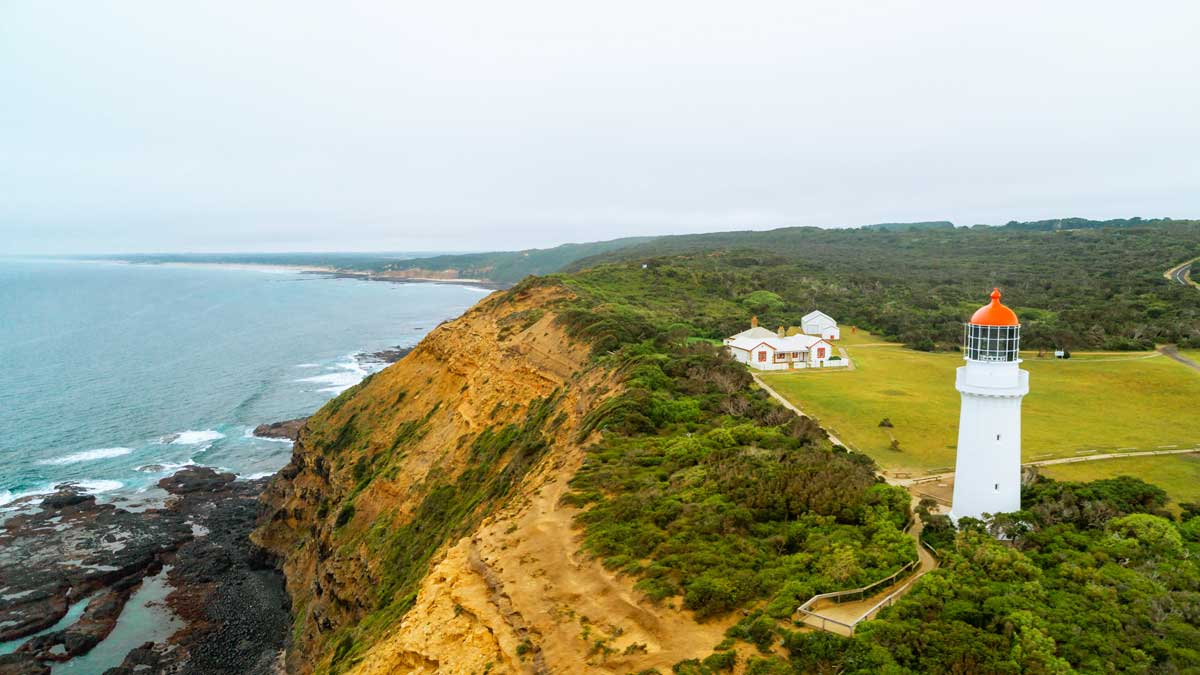
The views are stunning on the Cape Schanck and Pulpit Rock Loop. Image: Visit Victoria
RACV Torquay Resort
Best known for its surfing culture, Torquay is home to Bells Beach and Jan Juc Beach. See for yourself how the Surf Coast got its name on these scenic coastal trails.
Surf Coast Walk
- Length: 44km
- Ability: Easy - Advanced (depending on track)
- Dogs: Yes (on leash)
The Surf Coast Walk follows the famous Great Ocean Road along one of Victoria’s most popular coastlines, from Torquay to Aireys Inlet. With golden beaches, rugged cliffs and eucalyptus-scented air, the Surf Coast Walk offers coastal magic.
Conveniently broken into 12 distinctive trails, each walk allows you to choose your own adventure across one day or many. Beginners can look at the 1.6km Torquay Promenade trail, while more experienced hikers might enjoy exploring the Sunnymead-Urquart Bluff and Sunnymead Trail (3km), featuring a rougher track with rugged terrain.
Notes: Bring binoculars between May and October for the chance to spot migrating whales.
Point Addis and Bells Beach Trail
- Length: 10.8km
- Ability: Moderate
- Dogs: Yes (on leash)
This coastal loop may be on the longer side, but its surf beaches and ocean views are more than worth the effort. Taking about 2 hours 45 minutes to walk, start from Point Addis Carpark and walk along the beachfront, covering Addiscot Beach and Southside Beach and Bells Beach. You'll then turn inland along the Surf Coast Walk and Jarosite Track, with plenty of wattle trees, paper daisies and scrubby gums. Just plan your hike so you won't be walking on the beach at high tide!
Notes: Bells Beach is one of Australia's most famous surfing spots, home to one of world's biggest surfing competitions: the Rip Curl Pro.
Anglesea Heath Walk
- Length: 6.42km
- Ability: Intermediate
- Dogs: Yes (on leash)
Venture further out towards Anglesea and witness the vivid colours of the coast, with ochre cliffs, a brilliant blue ocean and dappled green heathlands along the Anglesea Heath Walk. This is the sixth (of 12) section alongthe Surf Coast Walk, covering the section from Point Addis to Anglesea.
Notes: Combine this walk with Anglesea Riverbanks, an easy stroll along the river that conveniently passes barbecues, playgrounds and cafes.

Bells Beach is a famous surfing beach in Torquay. Image: Visit Victoria
RACV Goldfields Resort
Steeped in history and full of vibrant culture, Creswick has plenty to offer the avid explorer, including some of regional Victoria's best historical experiences, along with some amazing walks.
St George's Lake Loop Walk
- Length: 1.8km
- Ability: Easy
- Dogs: Yes (on leash)
If you prefer lakeside views, try cruising the gently undulating track around the shores of St George's Lake - once a mining dam known as Govvy Dam. Perfect for families and nature enthusiasts, this picturesque walk only takes around half an hour to complete and offers the opportunity to spot waterbirds. Finish off with a picnic by the BBQ area near the carpark.
Notes: There are wheelchair-accessible ramps to the picnic area and viewing platform.
Creswick Heritage Walk
- Length: 8.5km
- Ability: Intermediate
- Dogs: Yes (on leash)
Start the Creswick Heritage Walk right from the centre of town, where there are plenty of parking options. Venture through the University of Melbourne's Creswick campus before walking part of the Goldfields Track past several points of interest, including some former stables, the La Gerche Forest Walk, and the northern part of St George's Lake. Extend your walk with a loop around St George's Lake if you like.
Notes: The La Gerche Forest Walk is named for the 100-year-old trees planted by Creswick’s first forest bailiff, John La Gerche.
Creswick Miner's Walk
- Length: 25.4km
- Ability: Intermediate
- Dogs: Yes (on leash)
This section of the celebrated 210km Goldfields Track takes you on a historical journey from Creswick to Ballarat. It's part of the longer Eureka Walk section, which takes hikers from Creswick through Ballarat to Mount Buninyong. This historic walk follows the route that 200 Creswick miners took when marching to Ballarat, the site of the 1854 Eureka Stockade, to fight for justice. Look out for the quartz trail markers, which shone in the moonlight for the miners to follow.
Notes: Allow four to five hours one way, and be sure to wear comfortable shoes.
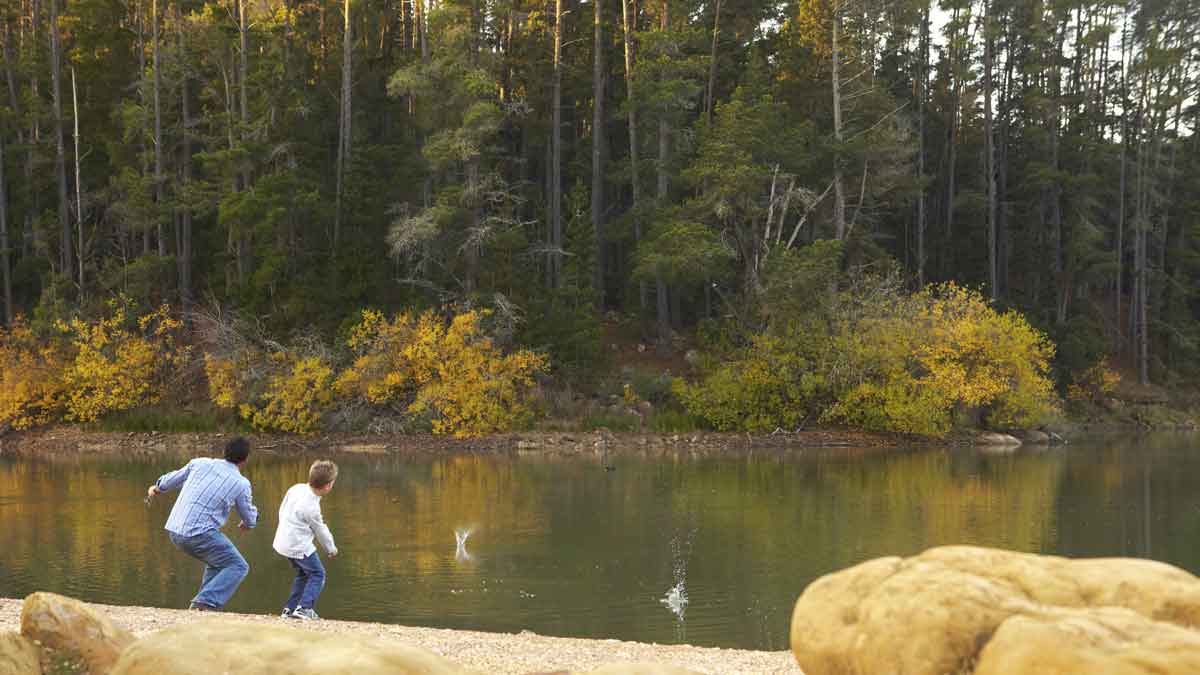
The St George's Lake Loop walk is great for families. Image: Visit Victoria
RACV Inverloch Resort
Situated on the Bass Coast a few hours southeast of Melbourne, Inverloch is a breath of fresh air sandwiched between picturesque countryside and popular beaches. Perfect for exploring, the walks surrounding Inverloch hold a variety of treasures waiting to be discovered.
Inverloch Foreshore Walking Track
- Length: 5km
- Ability: Easy
- Dogs: Yes (on leash)
You can't go past the Inverloch Foreshore Walking Track on a visit to Inverloch. Enjoy beautiful views of Anderson Inlet and Point Smythe, with stops along the way for picnic areas, exercise stations and the Rainbow Park playground. Stop for a swim in the turquoise waters, with quite a few cafes and shops across the road to peruse at your leisure too.
Notes: This track is pram and wheelchair friendly.
Screw Creek Nature Walk/Townsend Bluff Circuit
- Length: 3km
- Ability: Easy
- Dogs: Yes (on leash)
A great walk for families with kids, this gently undulating trail is partially boardwalk, winding through mangroves, tea trees and salt marsh up to a lookout on Townsend Bluff. Here you'll find beautiful views over Anderson Inlet. Begin (and end) from the parking area at the end of The Esplanade at Inverloch. The walk will take under half an hour to complete.
Notes: This scenic walk is called either the Screw Creek Nature Walk or the Townsend Bluff Circuit depending on your source.
Inverloch Surf Beach to The Caves
- Length: 7.7km
- Ability: Intermediate
- Dogs: Yes (on leash)
After a longer excursion? Walk from the swells of Inverloch Surf Beach along Bunurong Marine Park to The Caves. At their base, an excavation site is revealed at low tide called Dinosaur Dreaming. This is where more than 6,000 bones, teeth and footprints from small dinosaurs were found, all dating back 115 million years. Climb the stairs up to The Caves proper, a vantage point over the Bass Coast. Watch for whales if you're visiting between May and November.
Notes: Check the tides before you leave and make sure to only walk this route at low tide.
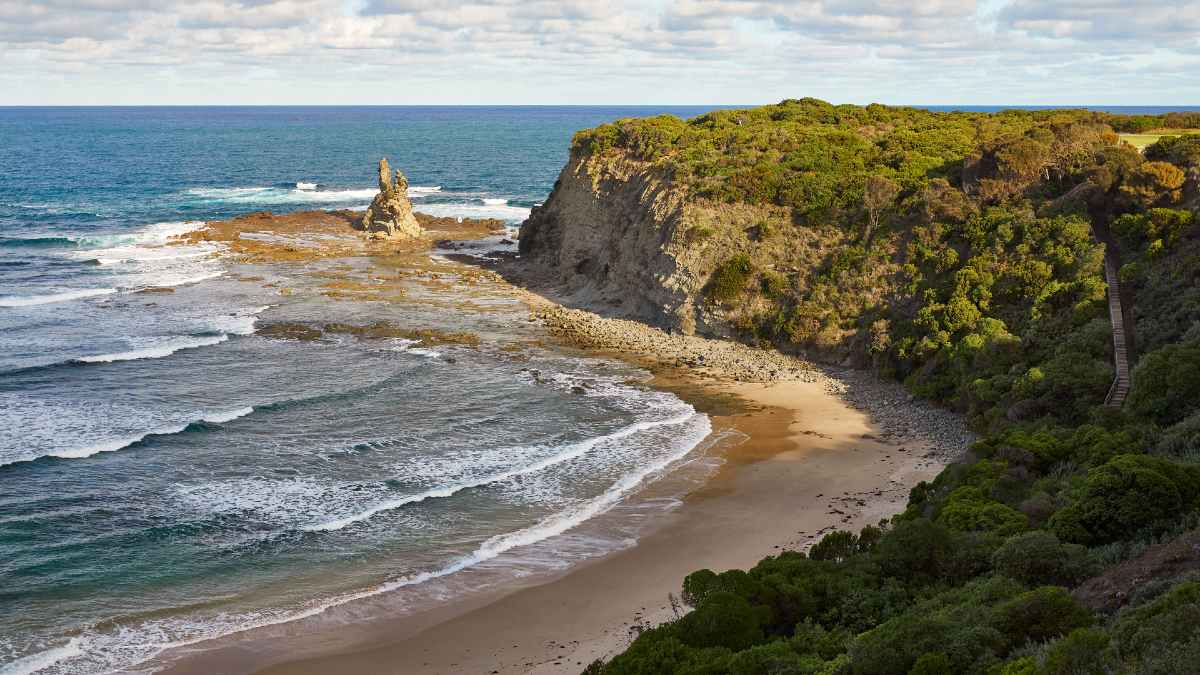
Eagle's Nest is a fantastic viewpoint on the Screw Creek Nature Walk.
RACV Cobram Resort
Slightly further afield, Cobram sits on the Murray River, the border between Victoria and New South Wales. Situated in the centre of what’s known as ‘the food bowl of Australia’, the area is known for its magnificent climate, fresh produce, and picturesque scenery.
Cactus Country
- Length: N/A
- Ability: Easy
- Dogs: No
One of the most unique walks on the list, Cactus Country is a 12-acre garden stuffed full of cacti and succulents from Mexico, Argentina and the African continent. Explore the eight garden trails before dropping into the onsite Mexican restaurant for lunch or a cactus ice cream. Pick up your own live cacti, or cactus-themed gifts (like cactus honey), from the gift shop before you leave.
Notes: RACV Members save on Cactus Country tickets.
Broken Creek Track
- Length: 4km
- Ability: Easy
- Dogs: No
For another walk unique to the Murray Region, check out Barmah National Park, featuring 60,000-hectares that are home to the largest river red gum forest in the world. Broken Creek Track is a loop that takes just under an hour to complete, meandering along Broken Creek and starting/finishing at Dharnya Centre: the cultural hub of the local Yorta Yorta people.
Notes: Broken Creek is also an area widely known for its great fishing.
Quinns Island Wetland Sanctuary
- Length: 3.2km
- Ability: Easy
- Dogs: No
Close to Cobram is a 40-hectare island full of waterbirds: Quinns Island Wetland Sanctuary. Cross over via the bridge off River Road. Pair the 2.5km Loop Track with the 1.2km walk to Cobrooga Beach and the 300m track to the Day Visitor Shelter to fully explore the area. You'll discover a large bird hide, pretty beaches and potentially even Aboriginal artefacts like flint tools, scar trees and middens.
Notes: Quinns Island was formed by a bend in the Murray River cut off by Scott's Creek.

Cactus County near RACV Cobram Resort is fun for the whole family. Image: Visit Victoria
RACV Healesville Country Club & Resort
While many people correlate Healesville with the Yarra Valley's boutique wineries, breweries and distilleries, this stunning area is filled with scenic routes, peaking valleys and mountains of lush greenery – that can be rewarded with a tipple at the end.
Badger Weir Loop Walk
- Length: 2.7km
- Ability: Intermediate
- Dogs: No
Taking just under an hour, the Badger Weir Loop Walk is located in the Yarra Ranges National Park near Healesville. The track offers lush riverside ferns, fungi and tall mountain ash trees as it follows Coranderrk Creek over several wooden bridges. Start and finish at the Badger Weir Picnic Area, which features public parking, toilets and BBQs.
Notes: The gate to Badger Weir opens at 8am. Closing hours may change throughout the year.
Maroondah Reservoir Park
- Length: 3km
- Ability: Easy - Intermediate
- Dogs: Yes (on leash - but not in picnic areas, lookout or dam wall)
Spend an afternoon exploring Maroondah Reservoir Park, with its classical domed gardens, 41m dam wall and a broad reservoir lake. There are four main tracks to explore here. The Lookout Track takes you from the carpark up the Rose Stairway to the dam wall for views over the area. Next, follow the Maroondah Forest Track to Henderson's Picnic Area. Here, a 1.4km track climbs to the top of Henderson's Hill and connects to other walks to and from Donnelley's Weir. There's also the Scenic Views Track, which wanders through grassy areas and large exotic trees to the top of the dam wall for views of the surrounding mountains.
Notes: When the dam overflows the spillway once or twice a year, the Falls Lookout gets you to the best views of the resulting waterfall.
Tanglefoot Loop
- Length: 10km
- Ability: Intermediate - Advanced
- Dogs: No
Explore Toolangi State Forest, a real rainforest area, via the stunning Tanglefoot Loop trail. Taking two to three hours to complete, the Tanglefoot Loop starts from the Wirrawilla Rainforest Carpark and winds though eucalypts and ferns over several short steep hills. Keep an eye out for parrots, rosellas, honeyeaters and even lyrebirds.
Notes: Bring proper hiking shoes to this walk: it's often wet and muddy.
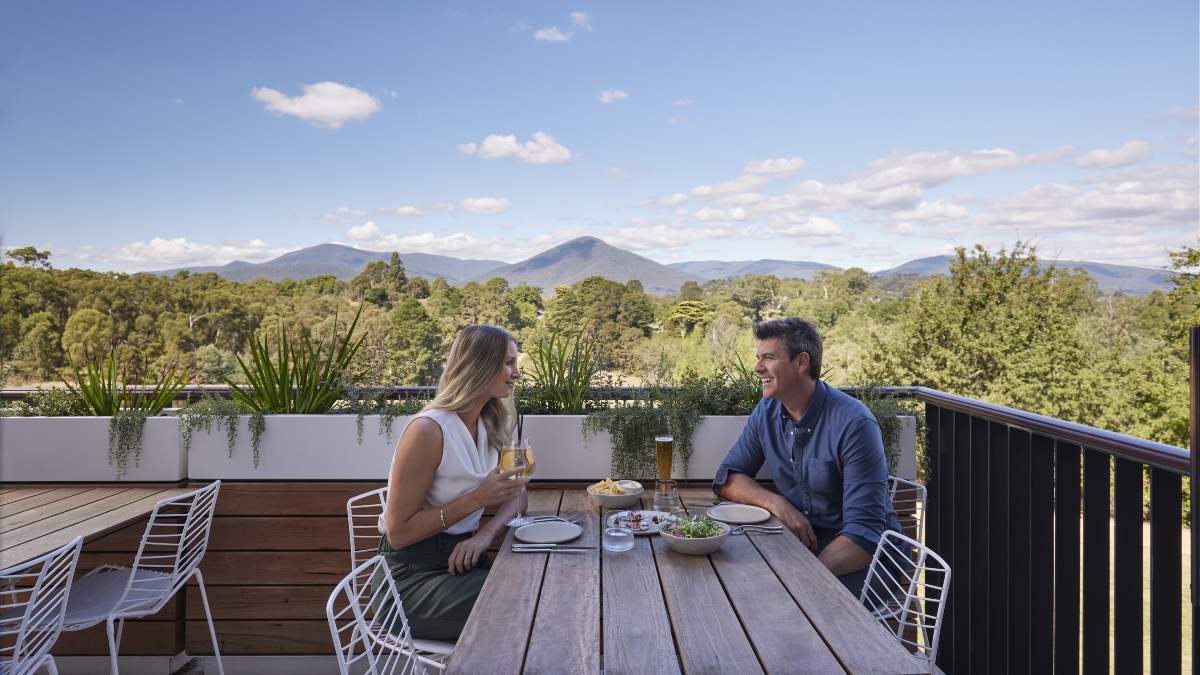
Stop in for a meal at RACV Healesville Resort's Banyalla after your walk.
RACV Noosa Resort, Sunshine Coast
As a beloved Australian tourist hotspot on Queensland’s Sunshine Coast, Noosa is known for its sunny climate, beautiful beaches, fabulous eateries and coastal scenery. The area is home to many hiking trails for different interests and abilities, from strolls with the dog on the beach to three-day trails for a coast waiting to be explored.
Noosa National Park - Hells Gates, Dolphin Point and Boiling Pot Loop
- Length: 9.8km
- Ability: Intermediate
- Dogs: No
Noosa National Park is full of incredible walking trails. Arguably the best loop walk is the one covering the hotspot lookouts Hells Gates, Dolphin Point and Boiling Pot - all of which feature waves crashing fiercely into rugged rocks. Taking about 2.5 hours to walk, this track begins at the Noosa Parade/Noosa Drive parking area and takes you along lots of coastal scenery. Look up for the chance to spot koalas in the trees, keep an eye out for turtles and dolphins in the waves, and scan the coastline for humpback whales between June and November.
Notes: The RACV Noosa Resort offers a free shuttle service between the resort and Noosa Main Beach, just off Noosa National Park.
Noosa River Foreshore Path
- Length: 3.4km
- Ability: Easy
- Dogs: Yes (on leash)
There's no better way to discover Noosa than with a walk along the Noosa River. This is a popular route for local walkers, runners and dogwalkers. Taking around 40 minutes to complete, the Noosa River Foreshore Path is especially lovely at sunrise or sunset. Enjoy the multidues of cafes and restuarants along the route and take your pick for brunch.
Notes: This walking track is wheelchair and pram friendly.
Alexandria Bay Walk
- Length: 4.2km
- Ability: Easy
- Dogs: No
Get your toes in the sand on the walk from Noosa to Alexandria Bay, filled with white sand and clear ocean waters. Starting from Parkedge Road, follow the wide sandy track through eucalypts, pink bloodwoods, coastal banksia and pandanus palms. The trail descends into some damp healthlands full of sedges, rushes and coral ferns before arriving at Alexandria Bay. Go for a dip before returning.
Notes: Bring binoculars on this route if you have them: it's a great location for birding.
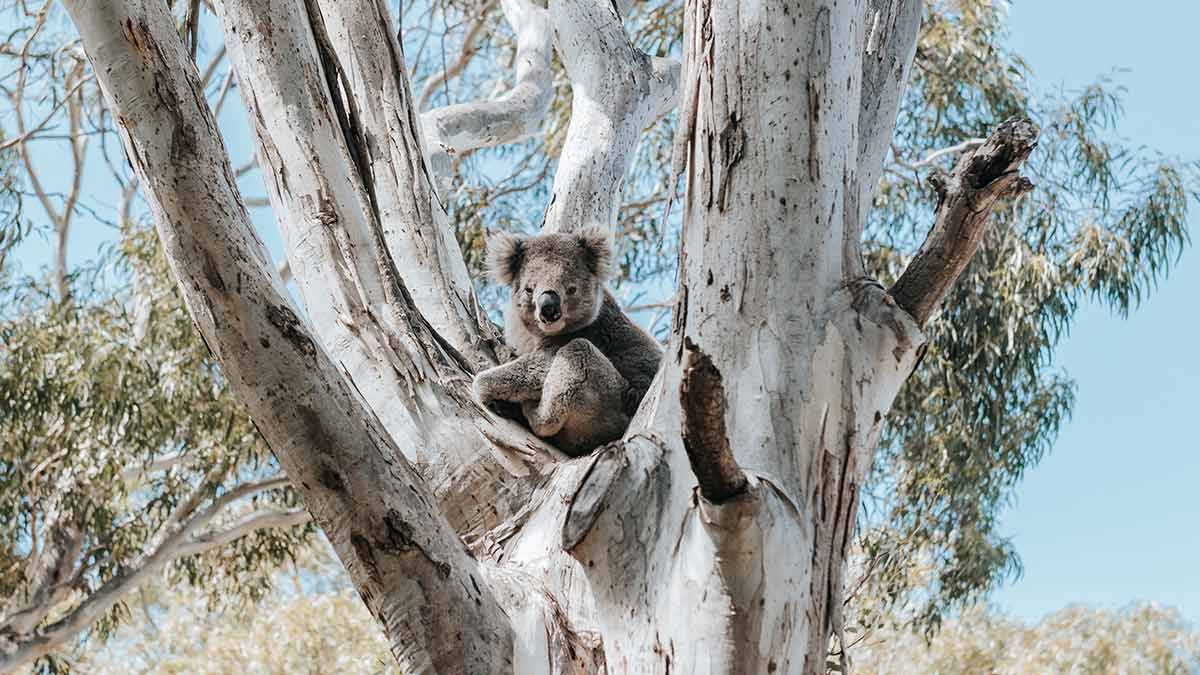
Keep an eye out for wildlife like koalas in Noosa National Park. Image: Visit Victoria
RACV Royal Pines Resort, Gold Coast
Burleigh Head Oceanview and Rainforest Circuit
- Length: 3.1km
- Ability: Easy
- Dogs: No
Offering stunning views of the coastline and the hinterland, Burleigh Head National Park is home to rainforests, mangroves, creeks, beaches and lots of Australian wildlife. This easy walking circuit only takes about an hour to complete and covers the best of the park. Starting at the rocky headland, you can enjoy ocean views with sea eagles soaring above and the chance to spot whales in spring. You'll then follow Tallebudgera Creek inland before joining the rainforest circuit. Take a few minutes to stop at both the Tumgun Lookout and Jebbribillum Lookout for views through the trees, and explore Echo Beach during low tide. Walk through eucalypt forest and a few short hills before ending up back at the carpark.
Notes: Parking can get competitive during peak times, so consider going early in the morning.
Twin Falls Circuit, Springbrook National Park
- Length: 4.2km
- Ability: Intermediate
- Dogs: No
It's just under an hour's drive from the RACV Royal Pines Resort to Springbrook National Park, but this walk is well worth the journey. The 1.5-hour Twin Falls Circuit is best tackled in an anti-clockwise direction as it winds through unique subtropical rainforest. You'll see rock formations, gorgeous birdlife, views all the way to Surfers Paradise, and two stunning waterfalls along the route lined with palms and brush box trees.
Notes: Tallanbana Picnic Area, located near the trailhead, offers public parking, toilets, sheltered picnic tables and information boards.
Nerang Goat Track Loop
- Length: 7.2km
- Ability: Intermediate
- Dogs: No
Head to Nerang National Park for a nice, challenging walk from the Nerang Velodrome into the eastern section of the park. The Nerang Goat Track Loop is named for its steep incline at the start of the track, but it levels out the rest of the way as it heads in a clockwise direction for about two hours and 15 minutes. There's plenty of dry rainforest and open eucalypt forest to admire here in the Gold Coast hinterland.
Notes: This route is also popular with cyclists, trail runners and horse riders. Be aware and keep to the left to allow them to pass.

The Springbrook Park Trail takes you along creeks, waterfalls and hidden natural gems. Image: Getty


